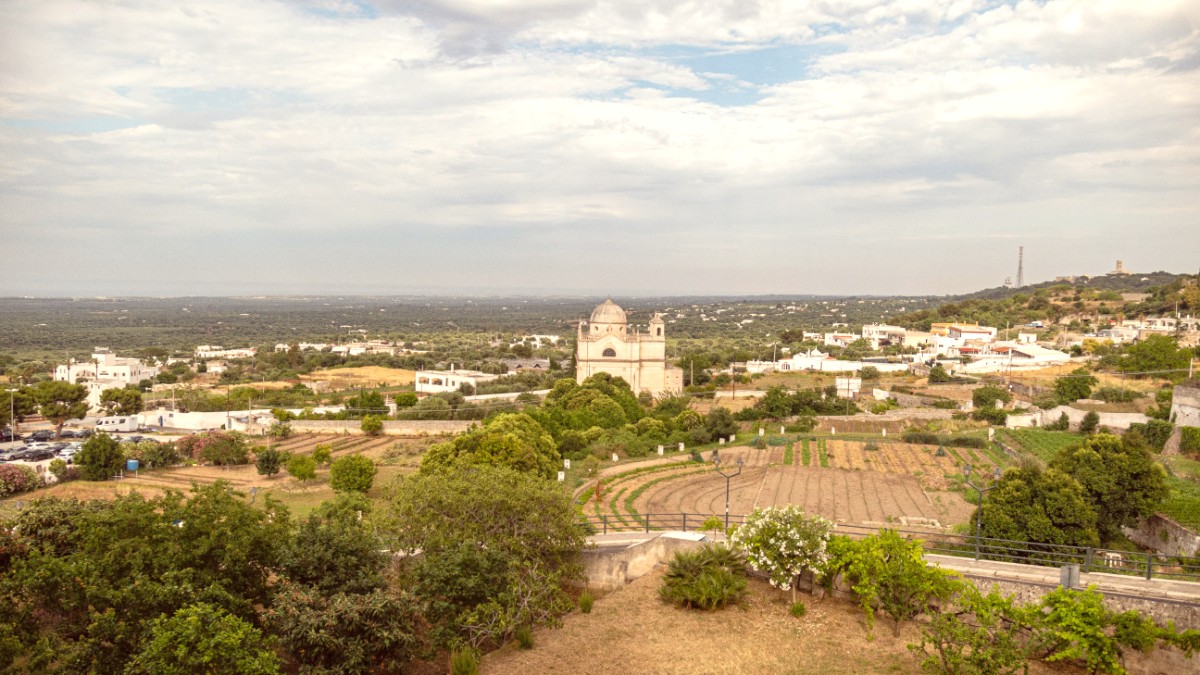
Puglia, Italy
Ostuni's historic center, the "White City," draws many visitors. Its maze-like structure and uniform white color craft an unique and picturesque environment.
The Cathedral, positioned at the highest point, dates from the 15th century, showing a Gothic facade and a beautiful rose window. Piazza della Libertà, the main square, has the Obelisco di Sant'Oronzo, dedicated to the city's patron saint.
Visiting from November to March has the fewest crowds, allowing more intimate city exploration.
Just outside Ostuni, this site holds the cave where "Delia" was discovered. The park also has other archaeological remains and scenic natural trails.
The entire district is a living historical site, displaying spontaneous medieval urban planning. Its organic growth formed a defensive town.
Noble palaces, like Palazzo del Vescovado and Palazzo Ayroldi, appear throughout the old town, showing the wealth of past aristocratic families.
A Baroque church near the museum, often for cultural events and exhibitions.
Many active and disused underground olive mills exist, some open for tours, giving a historical perspective on olive oil production.
Beyond the city, Ostuni is surrounded by beautiful natural landscapes.
This regional park along the coast near Ostuni has protected sand dunes, Mediterranean scrub, and ancient olive trees.
Panoramic terraces within Ostuni's historic center give breathtaking views of the "white city" and olive groves stretching to the Adriatic Sea, especially at sunset.
The Itria Valley has karst topography, leading to caves and sinkholes. Nearby Grotte di Castellana are a famous example.
Ostuni's coastline (Marina di Ostuni) has several Blue Flag beaches, like Rosa Marina and Pilone, for high environmental standards.
South of Ostuni, this protected marine and coastal area boasts pristine beaches and clear waters, ideal for snorkeling. Access to parts is restricted.
Parco delle Dune Costiere is good for birdwatching. Dolphin watching is possible off the coast; inquire with local boat tour operators in Monopoli.
The "Casa Museo" are small, private homes preserved in traditional style, sometimes open to the public, giving an intimate glimpse into past local life.
Cisternino and Locorotondo are nearby "white towns" in the Itria Valley, equally charming but often less crowded than Ostuni or Alberobello.
Porta Blu (Blue Gate) in a picturesque alley, the numerous staircases and arches, and views from the defensive walls have endless compositional possibilities.
Ostuni and its surroundings contain specialized attractions for unique interests, from ancient history to local traditions.
These sites highlight the rich layers of culture and natural beauty that characterize the region, offering a dive for curious visitors.
Explore the prehistoric past and Messapian roots of the region through significant archaeological sites.
Discover the distinctive architectural styles and historical structures that shape Ostuni's visual identity.
Experience the deep faith and artistic heritage through Ostuni's churches and spiritual monuments.
Discover the region's long-standing traditions in agriculture and industrial ingenuity, especially olive oil production.
Ostuni's coastal region boasts beautiful beaches and marine reserves, perfect for water activities and enjoying the Adriatic Sea.
Ostuni's coastline, Marina di Ostuni, features several Blue Flag beaches, signaling high environmental and quality standards for visitors.
Located south of Ostuni, this protected marine and coastal area has pristine beaches, sand dunes, and exceptionally clear waters, ideal for snorkeling.
Coastal towns like Villanova or areas near Torre Guaceto offer equipment rental for snorkeling, diving, kayaking, and stand-up paddleboarding.
Parco Naturale Regionale delle Dune Costiere from Torre Canne to Torre San Leonardo features protected sand dunes and Mediterranean scrub. It has great opportunities for walking, cycling, and birdwatching.
The wetlands within Parco delle Dune Costiere, like Fiume Morello, are especially good for birdwatching, especially during spring and autumn migratory seasons.
Parco di Gianecchia within Ostuni gives a smaller urban park, offering green space and a place for relaxation within the town itself after exploring the historic core.
Dolphin watching tours are possible off the coast. Inquire with local boat tour operators in nearby ports for organized excursions into the Adriatic Sea.
The coastline near Ostuni has rocky coves and sandy beaches interspersed, giving varying natural beauty and serene spots for quiet enjoyment of the sea.
Ostuni serves as a good base for exploring other enchanting towns and natural wonders in Puglia.
Discover the breathtaking coastal beauty of Puglia with these recommended excursions from Ostuni.
While many main attractions in Ostuni are walkable, renting a car is often recommended for exploring the wider Puglian region, including other towns and countryside Masserias.
This allows for flexibility and access to destinations not always served by public transport.
Beyond standard sightseeing, Ostuni has unique experiences that explore its culture and charm.
Immerse yourself in the authentic daily life and traditions of Ostuni and its people.
Engage with Puglia's celebrated food culture through interactive and sensory experiences.
Discover active ways to explore Ostuni's natural beauty, from coastal paths to olive groves.
Consider a Garmin Edge 530 Cycling Computer for advanced route planning during your rides.
Ostuni's evenings have a relaxed but lively atmosphere, with options for entertainment and socializing.
The historic center's numerous small bars are ideal for Aperitivo and after-dinner drinks.
Find local crafts, delicious produce, and unique keepsakes in Ostuni's markets and artisan shops.
A Puglia Food & Wine Recipes & Travel book is a lasting memory.
Expect higher crowds and longer waits at popular sites. Booking tours and activities in advance is highly suggested.
Fewer crowds and pleasant weather create ideal conditions for sightseeing. Most attractions remain open with regular hours.
Some smaller attractions or coastal businesses may close. Still, the historic center remains charming and uncrowded, suitable for peaceful exploration.
To truly experience Ostuni, blend iconic landmarks with hidden gems. Wander the back alleys, seek out local markets, and take time to absorb the city's unique ambiance beyond the main tourist paths.